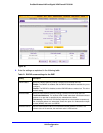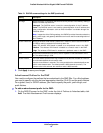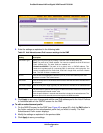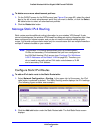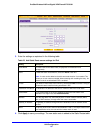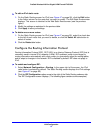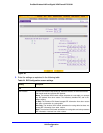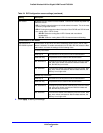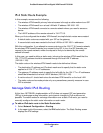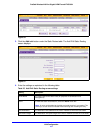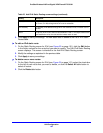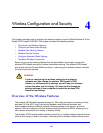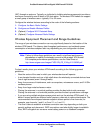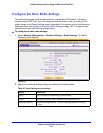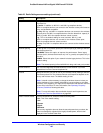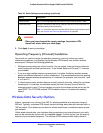
LAN Configuration
100
ProSafe Wireless-N 8-Port Gigabit VPN Firewall FVS318N
IPv4 Static Route Example
In this example, we assume the following:
• The wireless VPN fire
wall’s primary Internet access is through a cable modem to an ISP.
• The wireless VPN fire
wall is on a local LAN with IP address 192.168.1.100.
• The wireless VPN fire
wall connects to a remote network where you need to access a
device.
• The L
AN IP address of the remote network is 134.177.0.0.
When you first configured the wireless VPN firewall, two implicit static routes were created:
• A defau
lt static route was created with your ISP as the gateway.
• A second
static route was created to the local LAN for all 192.168.1.x addresses.
With this configuration, if you attempt to access a device on the 134.177.0.0 remote network,
the wireless VPN fire
wall forwards your request to the ISP. In turn, the ISP forwards your
request to the remote network, where the request is likely to be denied by the remote
network’s firewall.
In this case, you need to define a static route, informing the wireless VPN firewall that the
134.177.0.0 IP address should be accessed through the local LAN IP address
(192.168.1.100).
The static route on the wireless VPN firewall needs to be defined as follows:
• The d
estination IP address and IP subnet mask need to specify that the static route
applies to all 134.177.x.x IP addresses.
• The g
ateway IP address needs to specify that all traffic for the 134.177.x.x IP addresses
should be forwarded to the local LAN IP address (192.168.1.100).
• A met
ric value of 1 should work since the wireless VPN firewall is on the local LAN.
• The st
atic route can be made private only as a precautionary security measure in case
RIP is activated.
Manage Static IPv6 Routing
At this time, NETGEAR’s implementation of IPv6 does not support RIP next generation
(RIPng) to exchange routing information, and dynamic changes to IPv6 routes are not
possible. To enable routers to exchange information over a static IPv6 route, you need to
manually configure the static route information on each router.
To add an IPv6 static route to the Static Route table:
1. Select Netwo
rk Configuration > Routing.
2. In
the upper right of the screen, select the IPv6 radio button. The Static Routing screen
displays the IPv6 settings:



